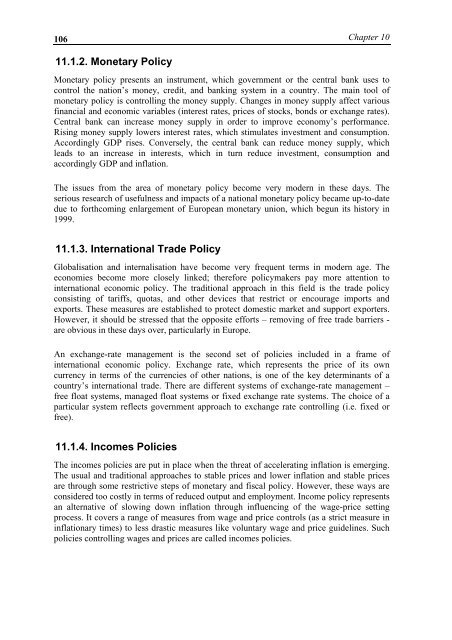MacroeconomicsI_working_version (1)
You also want an ePaper? Increase the reach of your titles
YUMPU automatically turns print PDFs into web optimized ePapers that Google loves.
106<br />
Chapter 10<br />
11.1.2. Monetary Policy<br />
Monetary policy presents an instrument, which government or the central bank uses to<br />
control the nation’s money, credit, and banking system in a country. The main tool of<br />
monetary policy is controlling the money supply. Changes in money supply affect various<br />
financial and economic variables (interest rates, prices of stocks, bonds or exchange rates).<br />
Central bank can increase money supply in order to improve economy’s performance.<br />
Rising money supply lowers interest rates, which stimulates investment and consumption.<br />
Accordingly GDP rises. Conversely, the central bank can reduce money supply, which<br />
leads to an increase in interests, which in turn reduce investment, consumption and<br />
accordingly GDP and inflation.<br />
The issues from the area of monetary policy become very modern in these days. The<br />
serious research of usefulness and impacts of a national monetary policy became up-to-date<br />
due to forthcoming enlargement of European monetary union, which begun its history in<br />
1999.<br />
11.1.3. International Trade Policy<br />
Globalisation and internalisation have become very frequent terms in modern age. The<br />
economies become more closely linked; therefore policymakers pay more attention to<br />
international economic policy. The traditional approach in this field is the trade policy<br />
consisting of tariffs, quotas, and other devices that restrict or encourage imports and<br />
exports. These measures are established to protect domestic market and support exporters.<br />
However, it should be stressed that the opposite efforts – removing of free trade barriers -<br />
are obvious in these days over, particularly in Europe.<br />
An exchange-rate management is the second set of policies included in a frame of<br />
international economic policy. Exchange rate, which represents the price of its own<br />
currency in terms of the currencies of other nations, is one of the key determinants of a<br />
country’s international trade. There are different systems of exchange-rate management –<br />
free float systems, managed float systems or fixed exchange rate systems. The choice of a<br />
particular system reflects government approach to exchange rate controlling (i.e. fixed or<br />
free).<br />
11.1.4. Incomes Policies<br />
The incomes policies are put in place when the threat of accelerating inflation is emerging.<br />
The usual and traditional approaches to stable prices and lower inflation and stable prices<br />
are through some restrictive steps of monetary and fiscal policy. However, these ways are<br />
considered too costly in terms of reduced output and employment. Income policy represents<br />
an alternative of slowing down inflation through influencing of the wage-price setting<br />
process. It covers a range of measures from wage and price controls (as a strict measure in<br />
inflationary times) to less drastic measures like voluntary wage and price guidelines. Such<br />
policies controlling wages and prices are called incomes policies.




